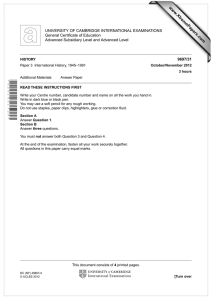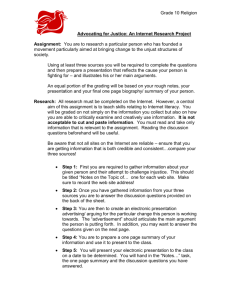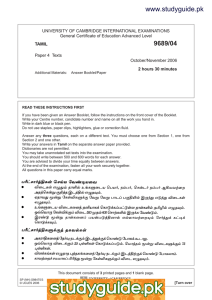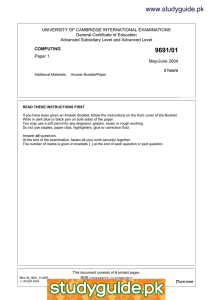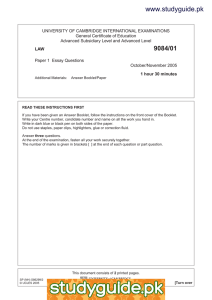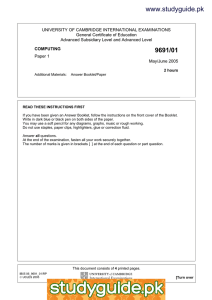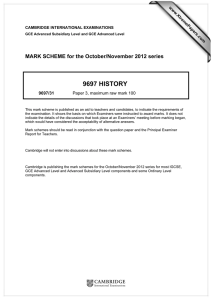www.studyguide.pk
advertisement
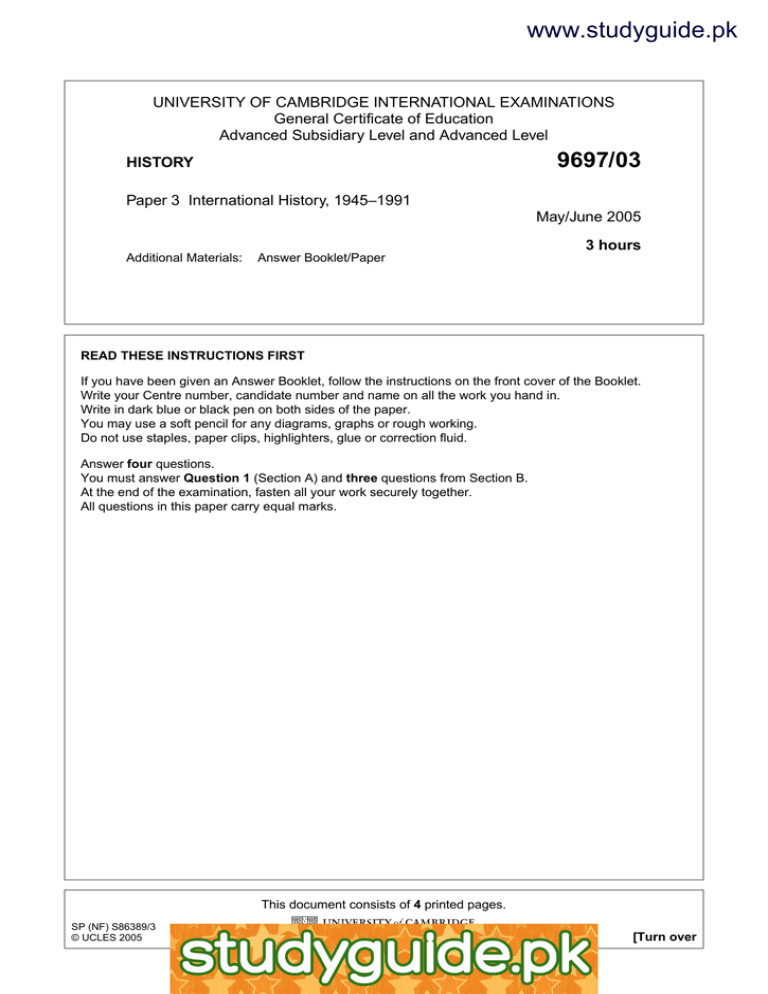
www.studyguide.pk UNIVERSITY OF CAMBRIDGE INTERNATIONAL EXAMINATIONS General Certificate of Education Advanced Subsidiary Level and Advanced Level 9697/03 HISTORY Paper 3 International History, 1945–1991 May/June 2005 3 hours Additional Materials: Answer Booklet/Paper READ THESE INSTRUCTIONS FIRST If you have been given an Answer Booklet, follow the instructions on the front cover of the Booklet. Write your Centre number, candidate number and name on all the work you hand in. Write in dark blue or black pen on both sides of the paper. You may use a soft pencil for any diagrams, graphs or rough working. Do not use staples, paper clips, highlighters, glue or correction fluid. Answer four questions. You must answer Question 1 (Section A) and three questions from Section B. At the end of the examination, fasten all your work securely together. All questions in this paper carry equal marks. This document consists of 4 printed pages. SP (NF) S86389/3 © UCLES 2005 [Turn over www.xtremepapers.net www.studyguide.pk 2 SECTION A You must answer Question 1. THE UN AND THE END OF THE SUEZ CONFLICT 1 Read the sources and then answer the question. Source A The Suez-Sinai conflict transformed the UN. It brought alive the ‘Uniting for Peace’ resolution of 1950, never previously applied. On 1 November the General Assembly began its first emergency session – an all-night one. On 4 November the Assembly asked the Secretary-General, Dag Hammarskjold, to produce a plan for a UN force within 48 hours. On 7 November it approved his full plan and voted him wide authority to ‘take all other necessary administrative and executive actions’. All this was thrust upon Hammarskjold, not initiated by him. But the UN Emergency Force (UNEF) could not have been conjured up to play its crucial role if he and his staff had not flung themselves into its creation with furious energy. And within a matter of days Hammarskjold found himself acting in the diplomatic even more than the administrative field. He had to work hard on President Nasser of Egypt to get agreement about the terms on which the force would enter Egypt. He could not get Israel’s agreement to operate on its side of the border at all. Andrew Boyd, a British journalist, in his book ‘United Nations: Piety, Myth and Truth’, 1962. Source B The creation of the UNEF was the condition on which the ceasefire had been brought about; the effective deployment of the force was the condition upon which the British, French and Israeli troops would withdraw. The first necessity was to make the UNEF into reality as quickly as possible. The two main problems were to recruit and transport the force to Egypt and to negotiate with Egypt its acceptance of this new international experiment upon its sovereign territory. The securing of Egyptian agreement proved to be the most difficult of the problems in establishing the UNEF. Hammarskjold in fact succeeded in establishing a basis for cooperation between the UN and Egypt upon which the UNEF operated smoothly and effectively for ten years. Hammarskjold’s energy and resourcefulness attracted considerable attention at the time and his reputation, except in France, Britain and Israel, had never stood higher. Brian Urquhart, in his biography of Dag Hammarskjold, UN Secretary-General, 1972. Source C The Suez crisis was, in my judgement, the finest hour of the General Assembly. Resolutions were adopted calling for a ceasefire and Israeli withdrawal and establishing a United Nations Emergency Force to replace the Anglo/French/Israeli forces in the Canal Zone and Sinai. The idea came from Lester Pearson, the Canadian Foreign Minister; the execution of his plan was carried out by Dag Hammarskjold and his admirable staff, including the American Ralph Bunche and the British Brian Urquhart. They performed miracles of improvisation. The General Assembly maintained the momentum until the British and French forces had left and American pressure had forced Israel to withdraw behind armistice lines. Anthony Parsons, British diplomat, in his book ‘From Cold War to Hot Peace: UN Interventions 1947–1995’, 1995. © UCLES 2005 9697/03/M/J/05 www.xtremepapers.net www.studyguide.pk 3 Source D In the Security Council, the British and the French vetoed resolutions by the United States and the Soviet Union demanding that Israel withdraw and others stay out of Egypt. Yugoslavia then used the ‘Uniting for Peace’ plan; since the Security Council was paralysed, the issue would be sent to the General Assembly. During the debate in the General Assembly on 1 November, Lester Pearson, the Canadian Foreign Minister, proposed a UN military force to take over positions from the British, French and Israelis. Hammarskjold had serious doubts at first about the wisdom or effectiveness of such a move. On 4 November, the General Assembly instructed Hammarskjold to submit a plan within 48 hours for the setting up of ‘an emergency international UN force’. Britain’s grudging acceptance of the principle of a UN force opened the way for Hammarskjold to persuade all sides into a UN solution. In a remarkable feat of management and energy, Hammarskjold put together the UN’s first peacekeeping force in a week. Stanley Meisler, an American journalist, in his book ‘United Nations: the First Fifty Years’, 1995. Source E It was in the General Assembly in the first three days of November that the UN’s first peacekeeping force began to emerge. The key person, in addition to Hammarskjold himself, was Lester Pearson. The United States, while remaining in the background, encouraged moves towards a UN-based solution. On 4 November the General Assembly passed a Canadian resolution proposing the creation of a United Nations Emergency Force. Hammarskjold quickly provided a preliminary plan. On 5 November the General Assembly authorised the establishment of the force. A more detailed plan was presented to the Assembly on 7 November, by which time British and French forces had occupied Port Said on the Suez Canal. Further basic principles were laid down in this extended blueprint. Britain and France would have favoured a UN operation in which their own forces had a prominent role. Both Hammarskjold’s proposal for a force free of great power involvement and the principle of Egyptian consent ruled this out. Neither Britain nor France was inclined to argue. Norrie MacQueen, a British academic, writing in 1999. Now answer the following question. How far do Sources A–E support the view that the work of Hammarskjold was the most important reason why the Suez conflict was brought to an end in November 1956? © UCLES 2005 9697/03/M/J/05 www.xtremepapers.net [Turn over www.studyguide.pk 4 SECTION B You must answer three questions from this section. You must not answer both Question 3 and Question 4. 2 Which of the following has the best claim to mark the start of the Cold War: Churchill’s Iron Curtain speech, 1946; the Truman Doctrine, 1947; the Berlin Blockade, 1948–49? Explain your answer. 3 Who or what was responsible for the globalisation of the Cold War? OR 4 Assess the relative contributions of America and the Soviet Union to the outcome of the Vietnam War. 5 How important was the West in the collapse of the USSR by 1991? 6 How successful were attempts to control the nuclear arms race between the superpowers in the period from 1960 to 1980? 7 ‘By the 1980s, the American dominance of the international economy had almost disappeared.’ Discuss. 8 Why did Africa experience serious problems of famine in the 1980s? Copyright Acknowledgements: Source A Source B Source C Source D Source E © Andrew Boyd; United Nations: Piety, Myth, and Truth, Penguin; 1962 © Brian Urquhart; Hammarskjold; pp183–4; Bodley Head © Anthony Parsons; From Cold War to Hot Peace: UN Interventions 1947–1994, Penguin © Stanley Meiser; United Nations: the First Fifty Years; pp. 108–112; Atlantic Monthly Press Norrie MacQueen; The United Nations Since 1945: Peacekeeping and the Cold War; pp24–25; © Addison Wesley Longman, 1999 Permission to reproduce items where third-party owned material protected by copyright is included has been sought and cleared where possible. Every reasonable effort has been made by the publisher (UCLES) to trace copyright holders, but if any items requiring clearance have unwittingly been included, the publisher will be pleased to make amends at the earliest possible opportunity. University of Cambridge International Examinations is part of the University of Cambridge Local Examinations Syndicate (UCLES), which is itself a department of the University of Cambridge. © UCLES 2005 9697/03/M/J/05 www.xtremepapers.net


